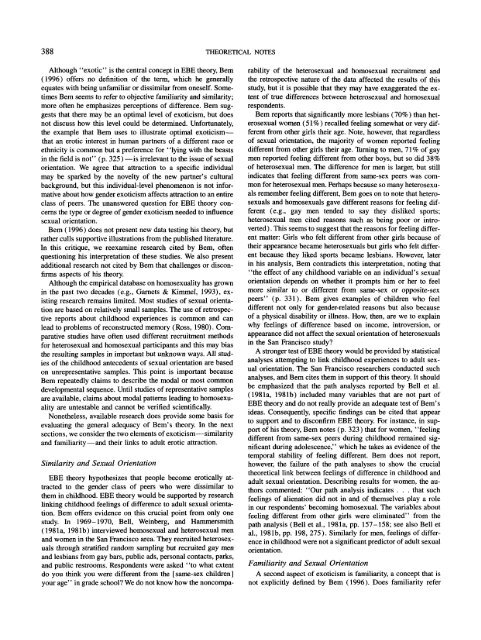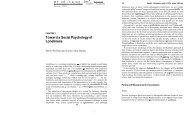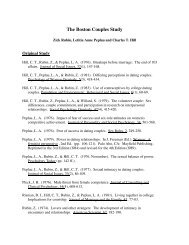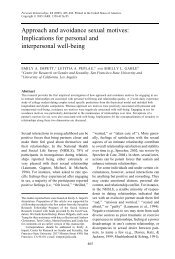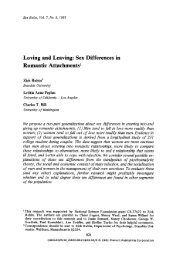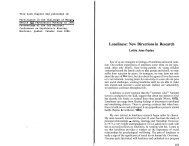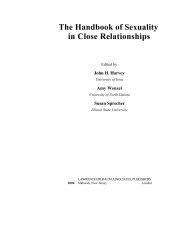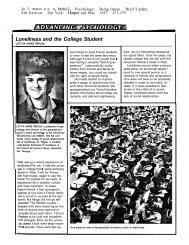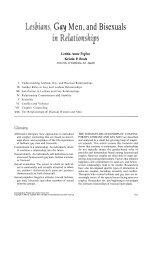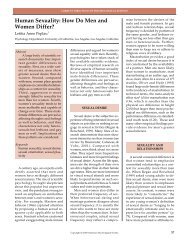"Exotic Becomes Erotic" Theory of Sexual Orientation - Anne Peplau ...
"Exotic Becomes Erotic" Theory of Sexual Orientation - Anne Peplau ...
"Exotic Becomes Erotic" Theory of Sexual Orientation - Anne Peplau ...
You also want an ePaper? Increase the reach of your titles
YUMPU automatically turns print PDFs into web optimized ePapers that Google loves.
388 THEORETICAL NOTES<br />
Although "exotic" is the central concept in EBE theory, Bern<br />
(1996) <strong>of</strong>fers no definition <strong>of</strong> the term, which he generally<br />
equates with being unfamiliar or dissimilar from oneself. Sometimes<br />
Bern seems to refer to objective familiarity and similarity;<br />
more <strong>of</strong>ten he emphasizes perceptions <strong>of</strong> difference. Bern suggests<br />
that there may be an optimal level <strong>of</strong> exoticism, but does<br />
not discuss how this level could be determined. Unfortunately,<br />
the example that Bern uses to illustrate optimal exoticism—<br />
that an erotic interest in human partners <strong>of</strong> a different race or<br />
ethnicity is common but a preference for "lying with the beasts<br />
in the field is not'' (p. 325) —is irrelevant to the issue <strong>of</strong> sexual<br />
orientation. We agree that attraction to a specific individual<br />
may be sparked by the novelty <strong>of</strong> the new partner's cultural<br />
background, but this individual-level phenomenon is not informative<br />
about how gender exoticism affects attraction to an entire<br />
class <strong>of</strong> peers. The unanswered question for EBE theory concerns<br />
the type or degree <strong>of</strong> gender exoticism needed to influence<br />
sexual orientation.<br />
Bern (1996) does not present new data testing his theory, but<br />
rather culls supportive illustrations from the published literature.<br />
In this critique, we reexamine research cited by Bern, <strong>of</strong>ten<br />
questioning his interpretation <strong>of</strong> these studies. We also present<br />
additional research not cited by Bern that challenges or disconfirms<br />
aspects <strong>of</strong> his theory.<br />
Although the empirical database on homosexuality has grown<br />
in the past two decades (e.g., Garnets & Kimmel, 1993), existing<br />
research remains limited. Most studies <strong>of</strong> sexual orientation<br />
are based on relatively small samples. The use <strong>of</strong> retrospective<br />
reports about childhood experiences is common and can<br />
lead to problems <strong>of</strong> reconstructed memory (Ross, 1980). Comparative<br />
studies have <strong>of</strong>ten used different recruitment methods<br />
for heterosexual and homosexual participants and this may bias<br />
the resulting samples in important but unknown ways. All studies<br />
<strong>of</strong> the childhood antecedents <strong>of</strong> sexual orientation are based<br />
on unrepresentative samples. This point is important because<br />
Bern repeatedly claims to describe the modal or most common<br />
developmental sequence. Until studies <strong>of</strong> representative samples<br />
are available, claims about modal patterns leading to homosexuality<br />
are untestable and cannot be verified scientifically.<br />
Nonetheless, available research does provide some basis for<br />
evaluating the general adequacy <strong>of</strong> Bern's theory. In the next<br />
sections, we consider the two elements <strong>of</strong> exoticism—similarity<br />
and familiarity—and their links to adult erotic attraction.<br />
Similarity and <strong>Sexual</strong> <strong>Orientation</strong><br />
EBE theory hypothesizes that people become erotically attracted<br />
to the gender class <strong>of</strong> peers who were dissimilar to<br />
them in childhood. EBE theory would be supported by research<br />
linking childhood feelings <strong>of</strong> difference to adult sexual orientation.<br />
Bern <strong>of</strong>fers evidence on this crucial point from only one<br />
study. In 1969-1970, Bell, Weinberg, and Hammersmith<br />
(198la, 1981b) interviewed homosexual and heterosexual men<br />
and women in the San Francisco area. They recruited heterosexuals<br />
through stratified random sampling but recruited gay men<br />
and lesbians from gay bars, public ads, personal contacts, parks,<br />
and public restrooms. Respondents were asked "to what extent<br />
do you think you were different from the [same-sex children]<br />
your age'' in grade school? We do not know how the noncompa-<br />
rability <strong>of</strong> the heterosexual and homosexual recruitment and<br />
the retrospective nature <strong>of</strong> the data affected the results <strong>of</strong> this<br />
study, but it is possible that they may have exaggerated the extent<br />
<strong>of</strong> true differences between heterosexual and homosexual<br />
respondents.<br />
Bern reports that significantly more lesbians (70%) than heterosexual<br />
women (51%) recalled feeling somewhat or very different<br />
from other girls their age. Note, however, that regardless<br />
<strong>of</strong> sexual orientation, the majority <strong>of</strong> women reported feeling<br />
different from other girls their age. Turning to men, 71% <strong>of</strong> gay<br />
men reported feeling different from other boys, but so did 38%<br />
<strong>of</strong> heterosexual men. The difference for men is larger, but still<br />
indicates that feeling different from same-sex peers was common<br />
for heterosexual men. Perhaps because so many heterosexuals<br />
remember feeling different, Bern goes on to note that heterosexuals<br />
and homosexuals gave different reasons for feeling different<br />
(e.g., gay men tended to say they disliked sports;<br />
heterosexual men cited reasons such as being poor or introverted)<br />
. This seems to suggest that the reasons for feeling different<br />
matter: Girls who felt different from other girls because <strong>of</strong><br />
their appearance became heterosexuals but girls who felt different<br />
because they liked sports became lesbians. However, later<br />
in his analysis, Bern contradicts this interpretation, noting that<br />
"the effect <strong>of</strong> any childhood variable on an individual's sexual<br />
orientation depends on whether it prompts him or her to feel<br />
more similar to or different from same-sex or opposite-sex<br />
peers" (p. 331). Bern gives examples <strong>of</strong> children who feel<br />
different not only for gender-related reasons but also because<br />
<strong>of</strong> a physical disability or illness. How, then, are we to explain<br />
why feelings <strong>of</strong> difference based on income, introversion, or<br />
appearance did not affect the sexual orientation <strong>of</strong> heterosexuals<br />
in the San Francisco study?<br />
A stronger test <strong>of</strong> EBE theory would be provided by statistical<br />
analyses attempting to link childhood experiences to adult sexual<br />
orientation. The San Francisco researchers conducted such<br />
analyses, and Bern cites them in support <strong>of</strong> this theory. It should<br />
be emphasized that the path analyses reported by Bell et al.<br />
(1981a, 1981b) included many variables that are not part <strong>of</strong><br />
EBE theory and do not really provide an adequate test <strong>of</strong> Bern's<br />
ideas. Consequently, specific findings can be cited that appear<br />
to support and to disconfirm EBE theory. For instance, in support<br />
<strong>of</strong> his theory, Bern notes (p. 323) that for women, "feeling<br />
different from same-sex peers during childhood remained significant<br />
during adolescence,'' which he takes as evidence <strong>of</strong> the<br />
temporal stability <strong>of</strong> feeling different. Bern does not report,<br />
however, the failure <strong>of</strong> the path analyses to show the crucial<br />
theoretical link between feelings <strong>of</strong> difference in childhood and<br />
adult sexual orientation. Describing results for women, the authors<br />
commented: "Our path analysis indicates . . . that such<br />
feelings <strong>of</strong> alienation did not in and <strong>of</strong> themselves play a role<br />
in our respondents' becoming homosexual. The variables about<br />
feeling different from other girls were eliminated" from the<br />
path analysis (Bell et al., 1981a, pp. 157-158; see also Bell et<br />
al., 1981b, pp. 198, 275). Similarly for men, feelings <strong>of</strong> difference<br />
in childhood were not a significant predictor <strong>of</strong> adult sexual<br />
orientation.<br />
Familiarity and <strong>Sexual</strong> <strong>Orientation</strong><br />
A second aspect <strong>of</strong> exoticism is familiarity, a concept that is<br />
not explicitly defined by Bern (1996). Does familiarity refer


